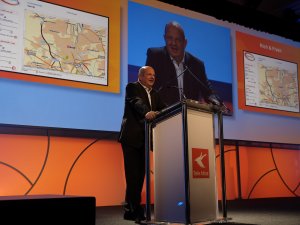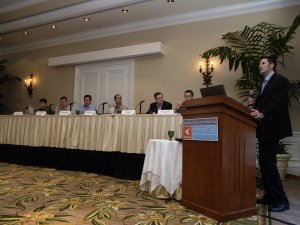 |
The event, which launched with three data related announcements (1, 2, 3), was pointedly not about geospatial data. Just a handful of sessions were geared to products or working with Tele Atlas. The remaining sessions, conversation in the halls and comments at evening events were about what you could do with the data, what the issues were in turning that data into businesses' successes and looking into the future.
Below, in no particular order, are the key themes I picked up from the speakers and attendees. Detailed coverage of individual sessions is available at our All Points Blog.
Intimacy of small devices. While the focus of this event is not really hardware, there's no denying it is part of the location business puzzle. How we interact with, depend on, humanize, and set expectations for these electronic companions came up time and again. One speaker put the connection issue in perspective this way: "If you left the house without your iPod, would you go back and get it? What if you forgot your cell phone?"
"Free" as part of the business model. More that one speaker and several attendees noted the imperative for free services. Free service offerings help educate the market and some research suggests that a high percentage of users will convert to paid subscriptions after a free trial. Others state what may seem obvious: you can't charge for something others offer for free. That came up in particular with regard to basic driving directions which are freely available in multiple places on the Web.
Consumers are driving the market. I'm not sure everyone agrees to this, but it's an interesting assertion nonetheless. Certainly, consumers have a lot to say about consumer focused apps (for example MapQuest) and vote with their clicks. I've argued elsewhere that the consumer experience with mapping is often enlightening its use in business and I stand by that. The big issue, if indeed consumers are driving the LBS train, is how to determine what they want. That challenge led at least one partner to make it clear to me that his company was not interested in the consumer market, only business to business.
 |
Increasing usage. Once providers get users to take advantage of any service, for example, a navigation system or search tool, the question is how to get them to use it more to make more revenue. A statistic bandied about from a navigation system provider suggests that the average user will tap the system for directions about three times a week. How can that number be increased? With location-based coupons? With local search? With more data?
Customization/personalization. These terms came up in virtually every session and highlight how the location-based experience must be focused on the individual. That means the provider or end user must be able to build a "My Yahoo"-like interactive system that speaks exactly to John or Jane Doe. It would be complete with the types of data he or she would want (weather, wind, shopping, points of interest etc.). This expectation is tied directly into that intimate relationship with the small devices.
Docking systems. Devices like laptops and iPods are often "docked" for use when they are not acting as true mobile devices. As location-based mobile devices mature, they too may be dockable. One future alluded to again and again includes a car with large screen, voice input, etc. where the brains of the navigation system are stored in the phone and its supporting services. For now, dedicated navigation systems are selling well. They are expected to do so for a few more years. How and when will that change with docking ports?
Capturing and using "community" data. The meaning of community here is broad and refers to input from both "regular people" and groups who want to share among themselves and perhaps outside the group. There are many informal "mashup" tools that capture this information (Platial, for one), but how it might be used in social and even business focused applications is still a bit murky. There is strong evidence of the value of community created data: consider how Amazon captures and uses reviews and buyer behavior to sell more books, movies and a host of other things. Tele Atlas is trying that very idea with its MapInsight tool.
User experience. The fact that iPods were mentioned throughout the event reinforces the idea that most user experiences with location information, especially on small devices, haven't reached the iPod's level of ease of use. Speakers indicated the need for the user interface to become invisible, various methods to input data (key-in, voice, GPS) and other user interface enhancements. One speaker was blunt when asked about the big leap he'd add if he could: "I'd make sure we do well what we currently say we offer."
Pricing. Pricing models are all works in progress. Users want variety (pay per view and subscriptions) while vendors try to figure out the right price point for these. Freakonmics' author Steve Levitt, who provided a keynote, noted how "bad" everyone is at pricing products and services.
[Disclosure: Tele Atlas paid for travel and lodging for this event.]